Dr. Esha Niyogi De has published a new, single-authored monograph, Women's Transborder Cinema: Authorship, Stardom, and Filmic Labor in South Asia, available on University of Illinois Press' website.
You are here
Instruments of Pakistan
Alphabetical List of Instruments
Borrindo
 |
The borrindo is a hollow clay ball with three to four holes. The top hole is larger than the others, which should be of the same size. The holes are arranged in an isosceles triangular form. The borrindo is made of clay commonly available in most of the central Indus Valley, and is thus often used in Sindh. This simply constructed instrument is sometimes made by children in the region. Artisans make larger borrindos with intricate designs and fire the clay. The notes for music are produced by blowing across the largest hole, while fingering the smaller holes to produce specific notes (images and information from Baloch 1988). | 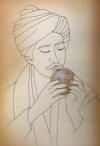 |
Dilo and Ghaghar
 |
The Dilo is a baked earthen jar; there is a special variety known as Ghaghar, which is larger than the average Dilo with a shorter mouth of the jar and more protuberance in the sides. Both are often used in Sindh. The clay for these instruments must be specially prepared by an expert potter to produce a consistent thin wall. The Dilo and Ghaghar are percussion instruments. Sound can be produced both by striking the sides of the jar, and manipulating the mouth. Traditionally, Dilo or Ghaghar are played as accompaniment for the Yaktaro (images and information from Baloch 1988). | 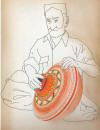 |
Yaktaro, Dando, and Chaparoon / Kharrtaloon
 |
While the Yaktaro, Dando, and Chaparoon/Khartaloon are distinctly different instruments traditionally used in Sindh, they are included here together as they are played simultaneously to provide both string and percussion. Often one individual will play more than one of these instruments while also singing.
1) The Yaktaro is traditionally a Sindhi 'single-stringed' instrument, although a more sophisticated form has emerged with two strings which is known by the same name. The Yaktaro is fashioned from a spherical gourd, often a pumpkin, which is dried, cut, and emptied. A piece of prepared skin is fastened over the open part of the gourd, and a long wooden rod is inserted in the sound chamber. The strings are usually made of steel secured around wooden rods and pegs, and held by a semi-circular support of clay or metal which is positioned on the skin surface. Played as a string instrument, the pitch of the tone is adjusted with the end pegs. 2) The Dando is one of two percussion instruments which can accompany the Yaktaro. This is a consists of a wooden rod, approximately 2 to 2 ½ feet long, and 1 inch in diameter. Bells are strung and fastened at one end through a hole in the rod. Below the group of bells is a thin circle of leather which acts as a handle. 3) Chaparoon or Karrtaloon are a pair of rectangular wooden pieces, about 6 inches wide and 3 centimeters thick. This is held by the player in one hand and hit together to produce rhythmic beats (images and information from Baloch 1988). |
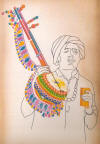 |
Kani / Narr
 |
The Narr is a very common traditional wind instrument of the Sindh and Baluchistan regions of Pakistan, as well as Iran and Turkey. In Sindhi, the term 'narr' simply means a reed plant which has stalks which can hollowed. The Narr instrument is usually made from a variety of different types of reeds, pierced with four equi-distant holes towards the end and left open at both ends. To produce a sound the player will blow horozontinally at the top end. The Narr is usually about 2 to 3 ½ feet long; when in a thinner and longer form is referred to as a Kani (images and information from Baloch 1988). | 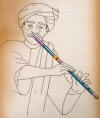 |
Naghara
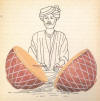 |
The term 'naghara' is the Sindhi form of the Arabic naqqarah. The rounded section of the naghara is made of baked clay, while the flat side consists of treated skin which is fastened around the rim with string which is tightened over the back of the bowl.
This percussion instruments is often played in pairs, where one naghara will produce low pitch beats called nar (the male) and the other for the high pitch bcats (the female). The instruments are beaten with short wooden sticks bent outward at the upper ends, called damka (image and information from Baloch 1988). |
Chung
 |
The chung is a jaw harp made of iron. The player puts part of the frame in the mouth, with open jaws, so that the chamber of the mouth amplifies the sound. The chung is vibrated with touches of the musician's fingers, with different tempos producing varying rhythms and tones (images and information from Baloch 1988). | 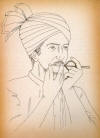 |
Kanjhyoon / Talyoon
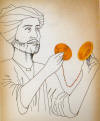 |
These are a pair of small brass discs, with a ciameter of approximately 2 to 3 inches in size. The percussion effect is produced by striking the discs together to procudce different rythems. The Kanjhyoon/Talyoon are often played in accompaniment to either instrumental or vocal music, and are popular in the Sindh region (image and information from Baloch 1988). |
Dhul / Dhol / Dhole / Dholak
 |
The Dhul or Dhol is a type of drum. The drum's sound chamber is typically fashioned from a single piece of a mango tree trunk. Both sides of the drum are covered in taunt goatskin, which is tightened with the placement of circular elastic sticks around the outer side. The larger side of the drum is called the 'bum' and the smaller side the 'tali', while the wooden drumstick is called a 'daunko'. The traditional size of these drums was quite large, and they could reportedly be heard at a distance of 5 to 6 miles. Today the Dhul/Dhol in common use in Sindh and the Punjab are smaller in size. The dhul/dhol also plays an important role in a popular for of Punjabi music called bhangra (images and information from Baloch 1988, information from Byrne 2003). | 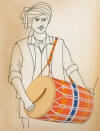 |
Sharnai
| The Sharnai is a wind instrument often used in Sindh as an accompaniment of the Dhul. In the past it was also called a Karnai.
The body of the Sharnai is made of wood with an inserted reed sounding device. The instrument has eight holes arranged in a straight line and a ninth hole, called the babiho, positioned below on the back side. There are three varieties of the Sharnai : 1) The Ghazzi is the smallest variety, approximately 6 inches long, and is used for playing the mourning tunes for Muharram. 2) Sharnai is the medium variety, approximately 8 inches long, and the most common form in the Indus Valley. 3) The Mutta, about 10 inches long, is the form most popular in more northern areas of Pakistan such as the Multan region (image and information from Baloch 1988). |
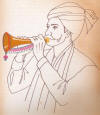 |
Surando / Saro / Saroz
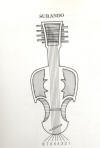 |
The name of this instrument, Surando is based on 'surayindah', a Persian word for one who produces tunes. The Surando is a common instrument in the Sindh, Balochistan and Frontier regions regions of Pakistan. In the Frontier region this instrument is known as called Saro, while in Balochistan it is called Saroz. The main part of the instrument is made with a variety of different types of wood, while the strings are traditionally constructed from horse hairs and intestines of sheep or goat. This instrument can have a varying number of strings, with more simple versions having 5-7 strings and the most complex having 11-13 strings (images and information from Baloch 1988). | 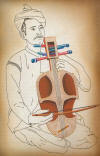 |
Murli / Punji
 |
The Murli or Punji is a wind instrument which consists of two parts; the upper part is made of a dried and hollowed gourd which acts as the main sound chamber. The lower part is constructed from two reed pipes which are joined together into a double barrel form and positioned below the sound chamber. On most of these instruments the reed section has eight holes, which are used to play tones for music. However, in some parts of Sindh there is an additional hole in the lower back end of the right pipe. This instrument is known as a Murli in Sindh, and a Punji in other parts of Pakistan. It is most commonly recognized for its popular use by snake charmers throughout South Asia (image and information from Baloch 1988). |
Pava / Beenu / Alghoza / Bainsiri / Doneli
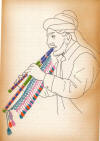 |
The simple double flute called a Pava or Beenu reportedly developed from a children's version known as the bainsiri. These are often played in Sindh. The identifying feature of this instruments is that it involves two paired flutes which are played together. While the most common form of this instruments involves two flutes of equal length, some have differently sized flutes joined together. These are also commonly called 'Alghoza' in Sindh. In Baluchistan there is a version of the double flute called the Doneli. The Doneli is considered best played as a solo instrument, although it can also be used in accompaniment to other instruments, especially stringed instruments (first image and information from Hessnetworks 2002, second image and information from Baloch 1988). |  |
Damboor
 |
The damboor is a stringed instrument originally invented in Egypt; it reportedly traveled to South Asia through the Middle-East and Persia. The instrument was popular with early Arab musicians, and remains in use in Sindh today. The Damboor traditionally had four strings, although new forms of the instrument are typically five stringed. The chamber is commonly made from one single hollowed out piece of wood (image and information from Baloch 1988). |
Danburo / Kamach / Kamachi
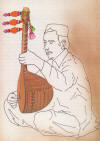 |
The Danburo is a stringed instrument traditionally found in the Kohistan and Las Bela regions of Pakistan. A smaller version of this instrument of this type (with a smaller chamber and long tail) is called Kamach or Kamachi. The Danburo has a large elliptical body made of wood, and three steel strings. It is most typically played using a small wooden pick called the Janok (image and information from Baloch 1988). |
Sarod
 |
The Sarod is an instrument derived from the Central and South Asian instrument the Rubab or Rabab. This string instrument has a metal fingerboard with no frets, and numerous strings. The membrane covering provides resonance in the sound chamber. It is usually played with a coconut pick. The Sarod is used in many parts of Pakistan including Baluchistan and Azad Kashmir (first image from Bina, second image and information from Courtney 2004). |  |
Bubul Tarang / Benju / Banjo
 |
This is a fairly new instrument in Pakistan, but is popular today in Balochistan. The benjo or banjo is basically a dulcimer. The Balochi version of the banjo is a large version, approximately one meter in length. It is often used in pieces with sarod accompaniment. This can be constructed with a variety of materials. It produces a bright, metallic sound (information from Baloch 2000 and Courtney 2004, image from Courtney 2004). |
Zerbagali
| This is a percussion instrument with a single head in an hourglass shape. The instrument is often found in Turkey and Iran as well as Pakistan. The body of the zerbagali is made from baked clay, which is decorated in different ways regionally. Many of these instruments are made by master potters who create designs in the clay before firing it. The head of the drum is typically animal skin, affixed to the clay body with cloth string (Information and image from Gold and Schalliol 2004). |
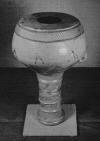 |
Tumbi
 |
The Tumbi is a traditional Punjabi stringed instrument, which has only one string and produces a high tone. The body of the instrument is made of various types of wood and the string of metal. Tones are produced with fingering positions at the top of the string. The Tumbi has become well known in recent times in the international music scene as it is used in a popular Punjabi style of music called bhangra (information from Lancashire 1997, Byrne 2003 and Nagpal; image from Nagpal). |
Chimta
 |
The chimta is another percussion instrument commonly used in the popular Punjabi form of music called bhangra. This is an instrument made of two long flat pieces of metal, typically iron, with pointed ends on one side and a ring on the other end. Along the sides of the metal strips are bells or loosely attached simple metal pieces. The player holds the joint in one hand and strikes the two sides together to produce a chiming sound (information from Nagpal, image from Indian Musicals 1998). |
Kartal
| The Kartal are a percussion instrument similar to the chimta in effect, if not design They are simply a pair of wooden blocks or frames that have been outfitted with small metal pieces or bells. The two blocks are struck together to provide a rythem for many types of folk music in South Asia (information and images from Courtney 2004). |  |
Sarangi / Saringda
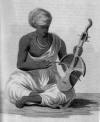 |
The sarangi/saringda are instruments closely related to the Saro instrument described above. This instrument is very common in Indian classical music and comes in many varieties. It is a stringed instrument, traditionally made with animal gut strings and a body carved from a single piece of wood. There is no fret on the neck, and the bridge is placed on a skin which is stretched over the body of the instrument. The sarangi/saringda varies in form because each school and region have a preferred shape, tuning method, and number of strings for these instruments. The saringda is commonly thought of as the folk version of the sarangi (Image and information from Courtney 2004). |
Daira
| This is a single headed percussion instrument which is not only found in Northern South Asia, Central Asia, and the Middle East, but also in parts of the Russian polar regions. This simple drum is formed by attaching a skin cover onto a wooden ring with glue and cloth ties. This is similar to the Persian daira and the Turkish del. Some daira have metal pieces attached to give them a tambourine-like quality. The daira is usually plyed while held vertically on one hand and beat with the other (Information and image from Gold and Schalliol 2004). | 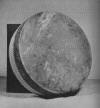 |
Tambur
| The tambur is a stringed instrument which is often used in Afghanistan as well as Pakistan. It can have a varying number of strings, commonly about eighteen, which can be made of metal, animal guts, or nylon. These strings are positioned over a resonating chamber which is often made of a hollowed gourd. The tambur has a long, hollow wooden neck which has tuning pegs on the side. It is often used either as a solo instrument or as an accompaniment for voice pieces (Information and image from Gold and Schalliol 2004). | 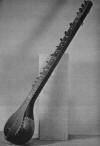 |
Daff /Dapphu /Daffali
 |
The Daf is quite similar to the daira, as a percussion instrument with one head that is played like a tambourine. In South Asia it is also called a dapphu, daffali. This instrument is usually quite large, about two feet across, and does not commonly have metal attached to produce a jingling sound. The daf is primarily a folk instrument (Information and image from Courtney 2004). |
References
Baloch, N. A. 1988 "Musical Instruments of The Lower Indus Valley" in Rhythms of the Lower Indus: Perspectives on the Music of Sind. Edited by Zohra Yusuf.
2004 'Balochi Music'.
Bina Musical Stores. Website: www.binaswar.com
Byrne, Richard. 2003 "Bollywood Beatbox" in The Globalist. August 23rd edition.
Courtney, David. 2004 "Indian Music" Website: www.chandrakantha.com/articles/indian_music
Gold, Peter and David Schalliol. 2004 "Folk Music and Instruments" Notes by Peter Gold, Photography by David Schalliol.
Hessnetworks. 2002 "MusicHeritage: Traditional Iranian Music Search Engine".
Indian Musicals. 1998 "Chimta" Website
Lancashire, Ian. 1997 Introduction to Punjab. Culture Gram.
Nagpal, Radikha. "Bhangra Instruments" from the Heritage of Punjab Bhangra Group of United Kingdom.
